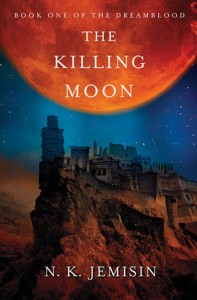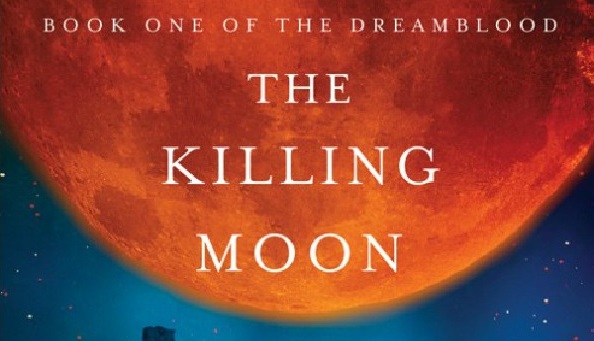Review: The Killing Moon
Spec-fic author, noted degenerate, and Dorkadia favorite Chuck Wendig posted a good blog piece last week, On the Subject of Diversifying Your Bookshelves. Short version: if you’re consciously author-blind, and buy whatever books look interesting without regard to origin, then it’s easy to unconsciously end up with a bookshelf full of the Same Ol’ Shit. I noticed this tendency in myself a while back*, especially when it comes to fantasy – I’ve got stacks and stacks of books by white dudes, featuring secondary-world Western European protagonists beating each other out of their chainmail. And it’s not like I do a genealogical survey of authors before I buy. That’s just what I like.
(*Pats self on back, eats cookie)
And, y’know, nothing wrong with those books. But there’s a lot to be said for getting out of your comfort zone, trying new things, expanding the palette, etc. – in reading as much as in anything else. And hell, if I’m basically gonna stay in the fantasy genre, I really ought to explore other parts of it than the bog-standard. So here’s one of the places I started, The Killing Moon, by self-described “mouthy fantasy writer chick” N.K. Jemisin.
That snappy four-word phrase is Ms. Jemisin’s Twitter bio, and her alternately hilarious and badass presence there (eating Vegemite, calling out bigots!) is absolutely one of the reasons I bought this book. I tried her debut The Hundred Thousand Kingdoms and it didn’t really take, delving a touch too deep into supernatural romance tropes for my taste. I’m pleased to say that I liked Killing a great deal more, a languorous high-fantasy read punctuated with bursts of some legitimately creepy horror.
 The setup: a fantasy city-state called Gujaareh, ruled by a divine king and managed by a priesthood whose magic consists of manipulating & drawing on dreams. In particular, the book focuses on the Gatherers, the small order responsible for giving peaceful, dreamlike deaths to suffering citizens who request them – or people judged to deserve them. Their dreams are repurposed to ease the suffering of others, Gujaareh is freed of the evil & corrupt, and everyone goes home happy. Seems legit, right? Of course, we’re quickly introduced to the older neighboring nation of Kisuati, whose ambassador stumbles into a conspiracy that envelops herself, the Gatherers, the above divine king, and eventually this whole area of the world.
The setup: a fantasy city-state called Gujaareh, ruled by a divine king and managed by a priesthood whose magic consists of manipulating & drawing on dreams. In particular, the book focuses on the Gatherers, the small order responsible for giving peaceful, dreamlike deaths to suffering citizens who request them – or people judged to deserve them. Their dreams are repurposed to ease the suffering of others, Gujaareh is freed of the evil & corrupt, and everyone goes home happy. Seems legit, right? Of course, we’re quickly introduced to the older neighboring nation of Kisuati, whose ambassador stumbles into a conspiracy that envelops herself, the Gatherers, the above divine king, and eventually this whole area of the world.
Gujaareh is a hell of a setting, drawn largely from Egyptian culture with a wild cocktail of Hindu, Zoroastrian, Christian, and half a dozen other mythologies feeding their religion/magic system. We first see the city through the eyes of the general protagonist, Ehiru, a workaholic, perfectionist Gatherer who somehow manages to take the business of harvesting dreaming souls too seriously; of course, as far as Ehiru is concerned, Gujaareh is the perfect civilization, his labors to remove corruption a divine mandate and his occasional questions the product of an overactive mind. Fellow narrator Sunandi, the ambassador from ancient Kisuati (based on historical Nubia, according to the author), has a different perspective – Gujaareh is a scary place, where holy assassins stalk the streets and the Sunset Prince, ruler of the city, might be good in the sack but is definitely not right in the head.
It’s a neat trick as regards the fantasy genre; lots of books deploy societies of color as The Exotic East, or The Savage South, or what have you, with strange and exotic customs. Jemisin introduces Gujaareh as the standard, and then immediately starts deconstructing it through Sunandi’s eyes; basically what you see from a lot of post-Martin fantasy, but with a culture that’s already, to a market of Western readers, tinged with the exotic and different. I might be making too much of it, but it’s a fun read.
Of course, that’s just the surface; the meat of Killing is in the low-key, deeply personal character interactions, best summed up by the third protagonist. Nijiri, Ehiru’s young apprentice, is the moral center of the book, but he’s also a confused, overwhelmed young man torn between defensiveness of his master and moral outrage over what the pair of them are embroiled in. The affection between the pair – and you could also say romance, even though that doesn’t really define it – is the spine of the story, manifesting in unexpected, moving ways. Tying the magic system that moves the plot to dreams, as personal an element as could be, gives Jemisin a lot of neat and surprising ways to link character and story.
The book falls down on occasion in prose, mostly as an outgrowth of the high fantasy elements. It’s hard to write about, say, sacred-prostitute-and-holy-assassin-dream-magic, without the occasional pulpy sentence; there’s an early example, where one of Ehiru’s victims/patients greets him with “So that is the rose’s soulname,” without any context behind what that sentence means. It made me wince, and a few other things did, but given the breadth and depth of the world & the people who inhabit it, some growing pains are inevitable and worth working past. Jemisin’s power as a writer is in the intrapersonal relationships discussed above, and, unexpectedly, in seriously scary shit. I don’t want to delve too deep into the villains of the story and their tools, as part of the fun is in the twists, but let’s just say that the book does explore the dark side of Gujaareh’s dream magic, and it is a yawning pit that produces some of the more chilling scenes I’ve read in traditional fantasy in a while.
Killing is technically part of a series called The Dreamblood; there’s a sequel, The Shadowed Sun, featuring the same setting and different characters (or rather, extremely minor characters in Killing promoted to protagonist), which I have yet to read. Honestly, I’d like to see Jemisin take a swing at horror sometime. I think she’d be great at it. But in lieu of that happenstance, The Killing Moon is a great read, whatever flavor of fantasy you tend to enjoy. Check it out.
…okay, I know you were thinking it too. Here. Fine.






